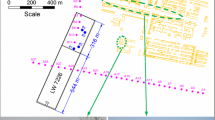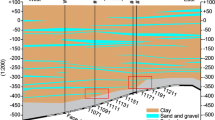Abstract
The roof abscission layer formed by coal mining changes dynamically with the mining of working face. The grouting of abscission layer is an important engineering method to reduce ground subsidence and protect ground buildings. By using empirical formula prediction, numerical simulation and tracer test, the dynamic development characteristics of abscission layer, storage space of grouting grout, diffusion law of grout and its influence on groundwater were studied. The results show that the separation space mainly exists in the top of water-conducting fracture zone, which develops and closes with the mining of working face. The grout is mainly stored in the horizontal abscission layer. Grouting grout diffuses with mining-induced fissures and groundwater flow. Under the dilution and purification of stratum and groundwater, the influence of grouting on groundwater quality is basically eliminated after 20 years.




















Similar content being viewed by others
Data Availability
Enquiries about data availability should be directed to the authors.
References
Bell FG, Stacey TR, Genske DD (2000) Mining subsidence and its effect in the environment: some differing examples. Environ Geol 40:135–152. https://doi.org/10.1007/s002540000140
Bureau TSCI (ed) (2000) Buildings, water bodies and railways and main shaft coal pillar preservation and the coal mining regulations. Coal Industry Publishing House, Beijing
Dong S, Ji Y, Wang H et al (2020) Prevention and control technology and application of roof water disaster in Jurassic coal field of Ordos Basin. J China Coal Soc 45(7):2367–2375
Feng G, Sun C, Wang C (2010) Research on goaf filling methods with super high-water material. J China Coal Soc 35(12):1963–1968
Guo W (2000) Study on the parameters of grouting bed-separation in mining-affected overburden. J of Chin Coal Soc 25:602–606
Guo W, Li Y, Zhang S et al (2014) Surface movement characteristics and control under the influence of highstand thick-hard strata. Electron J Geotech Eng 19V:6292–6303
Hao Y, Hao F, Chen J (2010) The effect of power plant fly ash piled up on the water environment and prevention countermeasures. Shanxi Water Resour 11:19–21
Hu G, Peng S, Zhang S (2010) Research on numerical simulation for transmission of contaminants in soil. Chin J Environ Eng 4:1659–1663
Julio-Miranda P, Ortíz-Rodríguez AJ, Palacio-Aponte AG et al (2012) Damage assessment associated with land subsidence in the San Luis Potosi-Soledad de Graciano Sanchez metropolitan area, Mexico, elements for risk management. Nat Hazards 64:751–765. https://doi.org/10.1007/s11069-012-0269-3
Karfakis MG, Topuz E (1991) Post mining subsidence abatements in Wyoming abandoned coal mines. Min Sci Technol 12:215–231. https://doi.org/10.1016/0167-9031(91)91137-7
Li Q, Zhang C (2021) Damage conduction model of high intensity mining in western mining area based on conservation of mining space and its application. J Min Saf Eng 38(1):1–8
Lin Q, Qiao W (2016) Water prevention and control technology of roof bed separation in Cuimu Mine. Coal Sci Technol 44:129–134
Liu G, Zhang H, Xu N (2006) Primary discussion of overburden separating location for safe grouting bed separating. Coal Min Tenchnol 11:77–79
Liu J, Liu R, Zhang X (2012a) Diffusion law model test and numerical simulation of cement fracture grouting. Chin J Rock Mech Eng 31:2445–2452
Liu R, Li S, Zhang Q (2012b) Research on application of tracer experiment analysis method to water hazards management in underground engineering. Chin J Rock Mech Eng 31:814–821
Lu C, Shu L, Yan L (2009) Determination of hydrogeologic parameters of karst aquifer based on tracer test. J Jilin Univ (Earth Sci Edi) 39:717–721
Ma L, Zhao B, Xu H et al (2019) Research on water inrush mechanism of fault coupling bed separation with fully-mechanized sublevel caving of ultra-thick coal seam. J China Coal Soc 44(2):567–575
Miao X, Zhang J (2014) Key technologies of integration of coal mining-gangue washing-backfilling and coal mining. J China Coal Soc 39(8):1424–1433
Palchik V (2003) Formation of fractured zones in overburden due to longwall mining. Environ Geol 44:28–38. https://doi.org/10.1007/s00254-002-0732-7
Palchik V (2005) Localization of mining-induced horizontal fractures along rock layer interfaces in overburden: field measurements and prediction. Environ Geol 48(1):68–80. https://doi.org/10.1007/s00254-005-1261-y
Qian M, Xu J, Wang J (2018) Further on the sustainable mining of coal. J Chin Coal Soc 43:1–13
Qiao W, Wang Z, Li W et al (2021) Formation mechanism, disaster-causing mechanism and prevention technology of roof bed separation water disaster in coal mines. J China Coal Soc 46(2):507–522
Siriwardane HJ, Kannan RSS, Ziemkiewicz PF (2003) Use of waste materials for control of acid mine drainage and subsidence. J Environ Eng 129:910–915. https://doi.org/10.1061/(ASCE)0733-9372(2003)129:10(910)
Su E, Liang Y, Zou Q et al (2019) Analysis of Effects of CO2 injection on coalbed permeability: implications for coal seam CO2 sequestration. Energy Fuel 33:6606–6615. https://doi.org/10.1021/acs.energyfuels.9b01190
Teng Y, Yan Z (1999) Study on law of overburden split developing in mining process. J China Coal Soc 24:25–28
Wang C, Feng G (2011) Grouting backfill technology with super high water material for overburden bed-separation and falling fractured zone. Coal Sci Technol 39(32–35):51
Wei L, Ye N, Zhu C (2013) Effects of exposed coal fly ash on groundwater contamination. Geo J China Univ 19:683–691
Wen L (2016) The mitigation of surface subsidence in coal mines. Energy Environ 27:350–359
Xu J, Ni J, Xuan D et al (2015a) Coal mining technology without village relocation grout injection into overburden. Coal Sci Technol 43:8–11
Xu J, Xuan D, Zhu W et al (2015b) Study and application of coal mining with partial backfilling. Meitan Xuebao/J China Coal Soc 40:1303–1312. https://doi.org/10.13225/j.cnki.jccs.2015.3055
Xuan D, Xu J, Wang B et al (2015) Borehole investigation of the effectiveness of grout injection technology on coal mine subsidence control. Rock Mech Rock Eng 48:2435–2445. https://doi.org/10.1007/s00603-015-0710-5
Xuan D, Xu J, Wang B (2016) Investigation of fill distribution in post-injected longwall overburden with implications for grout take estimation. Eng Geol 206:71–82
Yang L (2002) Re-understand the technology of reducing the subsidence due to mining by injecting grouts into separated beds in overlying disrupted strata by extraction. J China Coal Soc 27:352
Yin SX, Xia XX (2014) The application of chemical tracer experiments on exploring the mine water filling conditions. J Chin Coal Soc 39:129–134
Yin G, Yu G, Wang L (2006) Water-rock interactive effect between ash-water on ash-piling site and its limestone basis. J Saf Environ 6:32–34
Yuan L, Li P, Chen G (2001) Practice and study on reducing subsidence by filling the overburden separations in muti-seams. Coal Min Technol 1:46–49
Zhao D, Wang Y, Zhang W (2009) Comprehensive evaluation of grouting effect in separate strata layers of overburden. J Liaoning Tech Univ (Natl Sci) 28:766–769
Zhou H, Hou C, Sun X (2004) Solid waste paste filling for none-village-relocation coal mining. J China Univ Min Technol 33:154–158
Zhu W, Xu J, Lai W et al (2007) Research of isolated section-grouting technology for overburden bed separation space to reduce subsidence. J China Coal Soc 32:458–462
Zhu W, Xu J, Xu J (2017) Pier-column backfill mining technology for controlling surface subsidence. Int J Rock Mech Min 96:58–65
Zou Q, Lin B (2018) Fluid-solid coupling characteristics of gas-bearing coal subjected to hydraulic slotting: an experimental investigation. Energy Fuel 32:1047–1060. https://doi.org/10.1021/acs.energyfuels.7b02358
Zou Q, Liu H, Cheng Z et al (2019) Effect of slot inclination angle and borehole-slot ratio on mechanical property of pre-cracked coal: implications for ECBM recovery using hydraulic slotting. Nat Resour Res. https://doi.org/10.1007/s11053-019-09544-y
Acknowledgements
This work was financially supported by the National Natural Science Foundation of China (Grant 51704161), National Science and Technology Major Project of China (Grants 2016ZX05043005 and 2016ZX05045007), and Innovation fund of Coal Mining & Designing Department, Tiandi Science and Technology Co., Ltd (KJ-KCQN-01 and KJ-KCQN-03), which are gratefully acknowledged. We also thank the anonymous reviewers for their comments and suggestions to improve the manuscript.
Funding
The authors have not disclosed any funding.
Author information
Authors and Affiliations
Corresponding author
Ethics declarations
Conflict of interest
The authors have not disclosed any competing interests.
Additional information
Publisher's Note
Springer Nature remains neutral with regard to jurisdictional claims in published maps and institutional affiliations.
Rights and permissions
Springer Nature or its licensor (e.g. a society or other partner) holds exclusive rights to this article under a publishing agreement with the author(s) or other rightsholder(s); author self-archiving of the accepted manuscript version of this article is solely governed by the terms of such publishing agreement and applicable law.
About this article
Cite this article
Fan, Z., Cao, L., Yu, Q. et al. The Characteristics of Grout Diffusion in Reduce Subsidence Mining with Abscission Layer Grouting. Geotech Geol Eng 41, 553–575 (2023). https://doi.org/10.1007/s10706-022-02240-4
Received:
Accepted:
Published:
Issue Date:
DOI: https://doi.org/10.1007/s10706-022-02240-4




